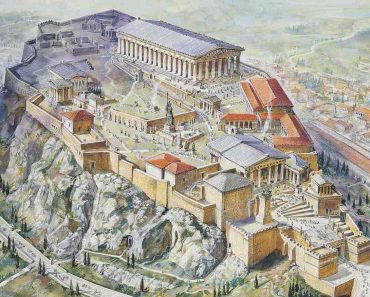
To this day, the undying myth of Atlantis may overshadow all other tales of cities at the bottom of the sea. Yet the very existence of the world’s most glorious lost underwater city is still debated by experts, with most saying it never existed. There are, however, several spectacular submerged cities from ancient times scattered across the clear blue waters of the Mediterranean Sea, with at least one of these located in Greece.
Though they have been underwater for quite some time, they all continue to tell their stories, which are just as captivating as the one of Atlantis, the ancient submerged Mediterranean city of Greece.
Pavlopetri, one of the ancient submerged cities in the Mediterranean located in Greece

The submerged city of Pavlopetri , thought to be the oldest sunken city in the world, is in Vatika Bay off the coast of southern Lakonia in the Peloponnese. It flourished as a port during the Bronze Age, and, according to UNESCO, it is more than five thousand years old.
Pavlopetri was discovered in 1967 by Nicholas Flemming. The ruins are submerged in only three to five meters of crystal-clear water, so that anyone snorkeling can see the full layout of the city, including graves, streets, and the outlines of buildings. The remains cover an area of more than five hundred thousand square feet, and the fact that its overall layout has remained intact is perhaps the most unique feature of Pavlopetri.
Researchers believe the city was submerged as a result of a series of three cataclysmic earthquakes that occurred in the area around 1000 BC.
Antirhodos, Cleopatra’s Kingdom, Egypt
In Alexandria‘s murky eastern harbor, off the coast of Egypt, lies the sunken palace of Cleopatra. Lost for 1,600 years, it was discovered by underwater archaeologist Franck Goddio in 1996. The Egyptian queen’s royal palace was built on the small, ancient submerged island of Antirhodos in the Mediterranean. The island sank, along with the palace, in the fourth century AD as the coastal city of Alexandria was hit by an earthquake and then a tsunami. The palace was destroyed and scattered under about ten meters of water.
Cleopatra‘s palace was said to be very opulent and surrounded by sphinxes and goddesses. Some 20,000 artifacts have been discovered in the bay where it once stood, including statues, jewelry, and pottery. Many are displayed in museums around the world. Today, public diving expeditions are organized at the sunken city site. Divers can still see two sphinxes that stand underwater, alongside many other ancient objects.
The ancient submerged Mediterranean city of Baiae, Italy
Once known as the “Las Vegas of the Roman Empire,” the ancient submerged Roman city of Baiae in the Mediterranean is located in the Gulf of Naples, a few kilometers from Pompeii and in the shadow of Mount Vesuvius. Baiae had a spectacular past since it was the place where Roman nobility used to go to escape the hustle and bustle of Rome and unwind in pleasure palaces. It had stunning views of the sea, natural hot springs, and opulent villas. Cicero, Caesar, Mark Anthony, Brutus, and Nero all had villas in Baiae.

However, Baiae wasn’t meant to last. It was built near a vast volcanic region, affected by the phenomenon of bradyseism (where the ground rises and sinks from volcanic activity). Over time, much of the city was swallowed by the sea. Today, it is a sprawling underwater archaeological park full of haunting ruins, including remnants of brick walls, floors made of precious marbles, stunning mosaics, grand villas, and statues telling their story from the bottom of the sea.
Thonis-Heracleion, Egypt

Thonis-Heracleion was an ancient port city on the coast of Egypt that for centuries was something of a mystery. It was a gateway into Egypt for ships coming from Greece carrying trade goods, soldiers, and even travelers. Thus, it was known as Thonis to the Egyptians and Heracleion to the Greeks. No trace of the city had ever been found, and its existence remained a legend until the year 2000, when the ancient submerged city in the Mediterranean was rediscovered in ruins seven kilometers off the coast of Egypt. It was found beneath a thick layer of sediment by archaeologist Franck Goddio.
It is believed Thonis-Heracleion had vanished under the waves of the Mediterranean Sea by the 8th century BC after a series of natural disasters, including an earthquake. Countless incredible artifacts have been found at the site of the ancient underwater city, including colossal statues, gold jewelry, Greek weapons, and bronze and ceramic objects.
Neapolis, Tunisia
The ancient Roman city once known as Neapolis, meaning “new city” in Greek, was originally founded in the fifth century BC. It was discovered in the deep sea off the coast of Tunisia in 2017 by a joint Tunisian-Italian archaeological team. According to experts, Neapolis was submerged by a powerful tsunami over 1,700 years ago.
The Romans left very few written records of Neapolis, possibly because the city had refused to pledge its allegiance to the Roman Empire, which makes its discovery all the more important. Scattered across the seafloor in an area spanning more than 20 hectares, archaeologists have found Roman street signs and monuments illustrating the city’s wealth. They have also discovered 100 tanks used to produce garum, a fermented fish sauce that was popular in ancient Rome and Greece.
Atlit Yam, Israel
The ancient village of Atlit Yam is located near Israel’s port city of Haifa. It dates back to roughly 7,000 BC, making it one of the oldest sunken civilizations in the world. It remained hidden beneath the waves for millennia until marine archaeologist Ehud Galili spotted its ruins in 1984 while looking for shipwrecks.

The neolithic settlement is submerged under 12 meters of water and despite being underwater for thousands of years it remains well preserved, with some of its structures still standing. A number of fascinating artifacts have been found at the site, ranging from animal bones to stone tools and carbonized plant remains. Remarkably, human skeletons discovered mostly in single graves remain largely intact.







